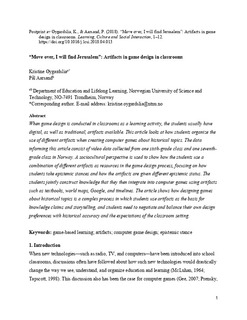| dc.contributor.author | Øygardslia, Kristine | |
| dc.contributor.author | Aarsand, Pål | |
| dc.date.accessioned | 2019-05-21T11:44:52Z | |
| dc.date.available | 2019-05-21T11:44:52Z | |
| dc.date.created | 2018-06-18T15:25:23Z | |
| dc.date.issued | 2018 | |
| dc.identifier.citation | Learning, Culture and Social Interaction. 2018, 19 61-73. | nb_NO |
| dc.identifier.issn | 2210-6561 | |
| dc.identifier.uri | http://hdl.handle.net/11250/2598279 | |
| dc.description.abstract | When game design is conducted in classrooms as a learning activity, the students usually have digital, as well as traditional, artifacts available. This article looks at how students organize the use of different artifacts when creating computer games about historical topics. The data informing this article consist of video data collected from one sixth-grade class and one seventh-grade class in Norway. A sociocultural perspective is used to show how the students use a combination of different artifacts as resources in the game design process, focusing on how students take epistemic stances and how the artifacts are given different epistemic status. The students jointly construct knowledge that they then integrate into computer games using artifacts such as textbooks, world maps, Google, and timelines. The article shows how designing games about historical topics is a complex process in which students use artifacts as the basis for knowledge claims and storytelling, and students need to negotiate and balance their own design preferences with historical accuracy and the expectations of the classroom setting. | nb_NO |
| dc.language.iso | eng | nb_NO |
| dc.publisher | Elsevier | nb_NO |
| dc.rights | Attribution-NonCommercial-NoDerivatives 4.0 Internasjonal | * |
| dc.rights.uri | http://creativecommons.org/licenses/by-nc-nd/4.0/deed.no | * |
| dc.title | “Move over, I will find Jerusalem”: Artifacts in game design in classrooms | nb_NO |
| dc.type | Journal article | nb_NO |
| dc.type | Peer reviewed | nb_NO |
| dc.description.version | acceptedVersion | nb_NO |
| dc.source.pagenumber | 61-73 | nb_NO |
| dc.source.volume | 19 | nb_NO |
| dc.source.journal | Learning, Culture and Social Interaction | nb_NO |
| dc.identifier.doi | 10.1016/j.lcsi.2018.04.013 | |
| dc.identifier.cristin | 1592004 | |
| dc.description.localcode | © 2018. This is the authors’ accepted and refereed manuscript to the article. Locked until 7.06.2020 due to copyright restrictions. This manuscript version is made available under the CC-BY-NC-ND 4.0 license http://creativecommons.org/licenses/by-nc-nd/4.0/ | nb_NO |
| cristin.unitcode | 194,67,70,0 | |
| cristin.unitname | Institutt for pedagogikk og livslang læring | |
| cristin.ispublished | true | |
| cristin.fulltext | original | |
| cristin.qualitycode | 1 | |

